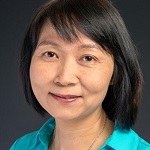Ultrafast Dynamics of Excited States in Semiconductor Moiré Superlattice
This webinar is hosted By: Ultrafast Optical Phenomena Technical Group
09 July 2024 10:00 - 11:00
Eastern Daylight/Summer Time (US & Canada) (UTC -04:00)Moiré superlattices are formed when two vanderWaals layers are stacked vertically with a controlled twist angle. Transition metal dichalcogenides (TMDs) are semiconductor building blocks with highly tunable optical properties. After reviewing some early studies identifying moiré excitons (bound electron-hole pairs), Prof. Li will discuss how their dynamics are tunable by the twist angle and how a powerful ultrafast spectroscopy tool, two-dimensional coherent electronic spectroscopy, reveals quantum dynamics of doped TMD monolayers and bilayers.
Subject Matter Level: Intermediate - Assumes basic knowledge of the topic
What You Will Learn:
• New quasiparticles in the most advanced semiconductor heterostructures; a powerful spectroscopy method and how it is applied to study ultrafast dynamics of quasiparticles in moiré superlattices
Who Should Attend:
• Graduate students and researchers trying to learn the optical properties of emerging semiconductor heterostructures or those interested in ultrafast spectroscopy.
About the Presenter: Elaine Li from University of Texas, Austin
 Prof. Li is a professor in the physics department at the University of Texas-Austin. She received her Ph.D. at the University of Michigan in 2003 and worked as a postdoctoral researcher at JILA, Colorado. Since establishing her research group at the University of Texas in 2007, she has worked in several research areas including low-dimensional semiconductors, most recently in atomically thin van der Waals materials, magnetic materials, and nanophotonics. She has received several awards including the Presidential Early Career Award for Scientists and Engineers in the U. S. and a Sloan Fellowship. She was a Humboldt research fellow at the Technical University of Berlin between 2013-2015. She is a fellow of the American Physics Society and OPTICA.
Prof. Li is a professor in the physics department at the University of Texas-Austin. She received her Ph.D. at the University of Michigan in 2003 and worked as a postdoctoral researcher at JILA, Colorado. Since establishing her research group at the University of Texas in 2007, she has worked in several research areas including low-dimensional semiconductors, most recently in atomically thin van der Waals materials, magnetic materials, and nanophotonics. She has received several awards including the Presidential Early Career Award for Scientists and Engineers in the U. S. and a Sloan Fellowship. She was a Humboldt research fellow at the Technical University of Berlin between 2013-2015. She is a fellow of the American Physics Society and OPTICA.
